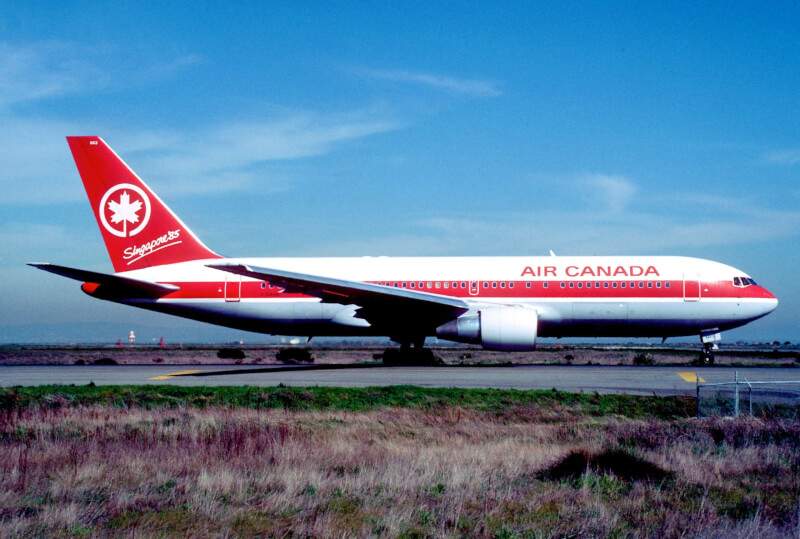
Flight 143 after landing at Gimli, Man. [Wikimedia]
“Oh fuck,” Pearson blurted into the cockpit voice recorder.
The engines of Air Canada Flight 143–what would come to be known as the “Gimli Glider” – had flamed out.
“The story of the Gimli Glider is the stuff legends are made out of,” Scott Deveau wrote to The National Post.
And marking its 40th anniversary, the Gimli Glider is a mathematical memoir of dramatic proportions, with initial miscalculations almost bringing the plane to its end and officers’ off-the-cuff computations saving the 61 passengers and eight crew members on board from certain death with a safe landing in Gimli, Man.
“It feels like yesterday,” flight passenger Pearl Dion told CBC. “My memories are still vivid.”
And it all started with the metric system.
“We also considered the possibility we were having some kind of a computer problem.”
On July 23, 1983, Flight 143 was on a multi-leg journey from Montreal to Edmonton, making a short stopover in Ottawa, where the ground crew discovered that a poor soldering job had knocked out the Fuel Quantity Information System before take-off.
At risk of upsetting customers and perpetuating delays, ground crew calculated the 767’s fuel load by measuring the precise gravity of jet fuel by hand. Along with an additional refuel in Ottawa, crew members were sure they hadn’t made any mistakes.
But in fact, they had made a mistake, three times. The refuelers had used the imperial factor of 1.77 pounds/litre, instead of 0.8 kg/litre, for Canada’s first metric plane model. Though Canada had gone metric since the 1970s.
The result? The presupposed 20,400 kilos of fuel left for the plane were actually only 9,144, less than half of what was needed to reach Edmonton.
Still, the 767’s first leg spoke little of the theatre that was about to ensue.
As passengers concluded their dinner over Red Lake, Ont., four beeps were heard from the 767’s EICAS.
“At that point,” Pearson told Soaring Magazine, “we believed we had a failed fuel pump in the left wing, and switched it off. We also considered the possibility we were having some kind of a computer problem.”
But the possibility of a potential computer problem was ruled out by another fuel pressure warning light and the left engine flaming out.

C-GAUN, the aircraft involved in the accident, taxiing at an airport in 1985. [Wikimedia]
Gimli was teeming with families, campers and go-cart racers.
In two minutes, the dreaded bong rang through the officers’ ears – and then, a foreboding silence.
“It’s a sound that Bob and I had never heard before,” Quintal also told Soaring Magazine. “It’s not in the simulator.”
Since the electrical system ran off the engines and both engines had stopped, the cockpit was now dark, leaving Pearson and Quintal with radio and standby instruments and a $40-million-dollar glider.
“As Pearson began gliding the big bird, Quintal ‘got busy’ in the manuals looking for procedures for dealing with the loss of both engines,” Soaring Magazine said. “There were none…”
But even while losing hydraulic pressure and flight controls fast, the flight wasn’t without hope. While Pearson was a gifted glider pilot, even owning a Blanik L-13 sailplane, Quintal had served in the Royal Canadian Air Force at the Gimli base, the exact landing strip they were aiming for.
Though Quintal’s knowledge of the area was extensive, and he had made the correct glide-slope calculations for Pearson’s landing, there was still one more problem, it was the Winnipeg Sports Car Club’s “Family Day.” Meaning, Gimli was teeming with families, campers and go-cart racers.
As the plane rapidly lost altitude, Pearson prepared for a “dead-stick landing,” the lack of hydraulic pressure causing the plane’s nose to slam against the strip as fires burst from the damage. With the plane’s tail three storeys in the air, Pearson and Quintal had made a safe emergency landing. The only injuries were from passengers hitting the asphalt when exiting from the rear emergency slide.
“We hit with a thump,” Pearson told The National Post.
“I looked up and there were three boys on bikes maybe 1,000 feet further down the runway.”
A life-changing experience for passengers, passersby and crew alike, Pearson and Quintal were later awarded the first-of-its-kind Fédération Aéronautique Internationale Diploma for Outstanding Airmanship. That particular 767 also continued to fly, after repairs, until 2008.
Passenger Dion later told CBC, “It’s been an interesting adventure, and since we’re still alive I’m enjoying it even more.”
Advertisement


















